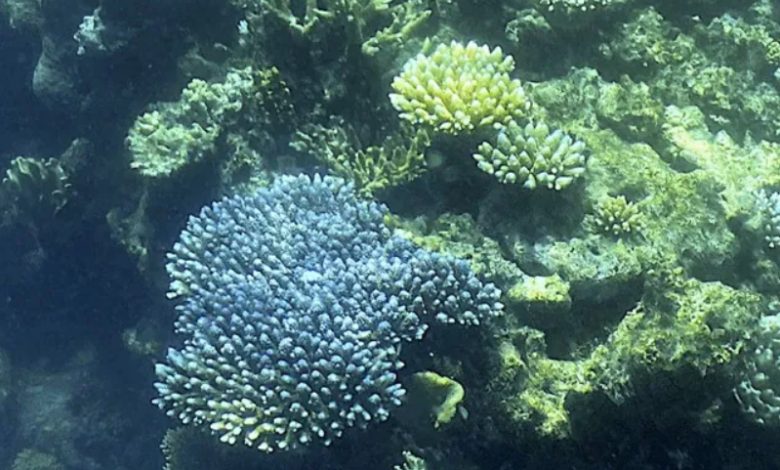2016 El Nino along with Increased Sea Surface Temperature & Heat Stress Result in Bleaching of Corals in the Andaman Sea and Loss of Live Cover: ZSI

The Zoological Survey of India (ZSI) scientists after a comprehensive study in the Andaman group of islands have revealed that massive coral bleaching (up to 83.6%) had been recorded in the Andaman Sea coastal areas including a maximum of 91.5% for South Andaman region. The ZSI Director Dr Dhriti Banerjee today stated that this has happened due to the impact of the El Nino event and increased sea surface temperature in 2016.
The detailed studies during pre and post-bleaching surveys made by the ZSI scientists found that a total of 23.58 percent of the live cover were lost due to this massive bleaching in 2016 in Andamans. A recent publication of GCRMN on the Status of Coral Reefs of the World: 2020 represented a gradual decrease in the live cover of hard corals from 32.3 percent in 1978 to 29.5 percent in 2019 whereas another study made in 2021 pointed out the rapid decline in coral calcification with the mean rate of 4.3 ± 1.9 percent annually mostly due to heat stress.
The destructive impacts of El Niño are well documented through the bleaching events across the world like the loss of 16 percent world’s reef cover in 1998 with the greatest mortality report of 70 percent from the Indian Ocean region whereas 93 percent bleaching of the coral colonies followed by 22 percent of dead corals were reported from Great Barrier Reef in 2016, stated Dr Banerjee.

The ZSI Director reiterated that These vulnerable ecosystems are on the verge of facing frequent threats due to the natural and anthropogenic means whereas their services towards sustainable and healthy reef habitats, coastal protection, development of tourism and recreational benefits and providing enormous scope for reef-associated faunal communities, providing economic support of the coastal population for their sustainable livelihood, supporting the pharmaceutical needs, etc. are exceedingly high. She said, it is high time for us to make ourselves aware enough to conserve this fragile ecosystem before their mass extinction.
It is to be mentioned that bleaching of scleractinian corals was recorded from the Andaman group of islands from April to May 2016. It was recorded that a total of 83.6% of scleractinian corals were bleached during this period. Maximum bleaching (91.5%) was recorded in the Andaman Sea region of South Andaman whereas it reached 83.2% in the North Andaman region as a minimum. There was no record of bleaching from the Bay of Bengal coast of North and Middle Andaman but the Bay of Bengal coastal areas of South Andaman displayed 74.2% of bleached corals. The studies were made up to the depth of 40 m and it was seen that the bleaching phenomenon was recorded up to the maximum depth of 30 m while the highest impact of bleaching was recorded at the depth range of 0-6 m followed by 6-15 m.
Dr Tamal Mondal, Scientist-C, Andaman and Nicobar Regional Centre of ZSI, Port Blair stated that the recovery of bleached corals was noticed from July to December 2016 mostly among the corals belonging to the Lobophylliidae, Merulinidae, Dendrophylliidae families while the minimum recovery was noticed among the corals of families Acroporidae and Poritidae. It was found that a mean recovery of 23.69% was recorded among the bleached corals of the Andaman group of islands based on the LIT studies. The maximum and minimum recoveries were recorded at the North Andaman region of the Andaman Sea coast (29.25%) and the South Andaman of the Bay of Bengal coast (19.18%), respectively.
Dr Mondal added that it is assumed that the luxuriant mangrove ecosystem is expected to buffer the heat waves and kept the corals of north and Middle Andaman unbleached and healthy although it is not yet proven by any experimental studies. Mangroves are known to purify water by absorbing nutrients from runoff as well as harmful algal blooms to keep them clear, which is a prerequisite for healthy coral reef ecosystems. Mangroves are also prime organisms that absorb carbon from carbon dioxide and take a notable role in carbon sequestration.
The ZSI scientists also stated that the recovery of the corals was observed after July 2016 with a maximum of 29.25% from the Andaman Sea coast of north Andaman. A mean of 23.69% of recovery was observed from all the bleached areas of the Andaman Sea and the Bay of Bengal but the remaining bleached corals were dead by December 2016.
Source: 24 MAY 2022 by PIB Kolkata
Photo: Internet






